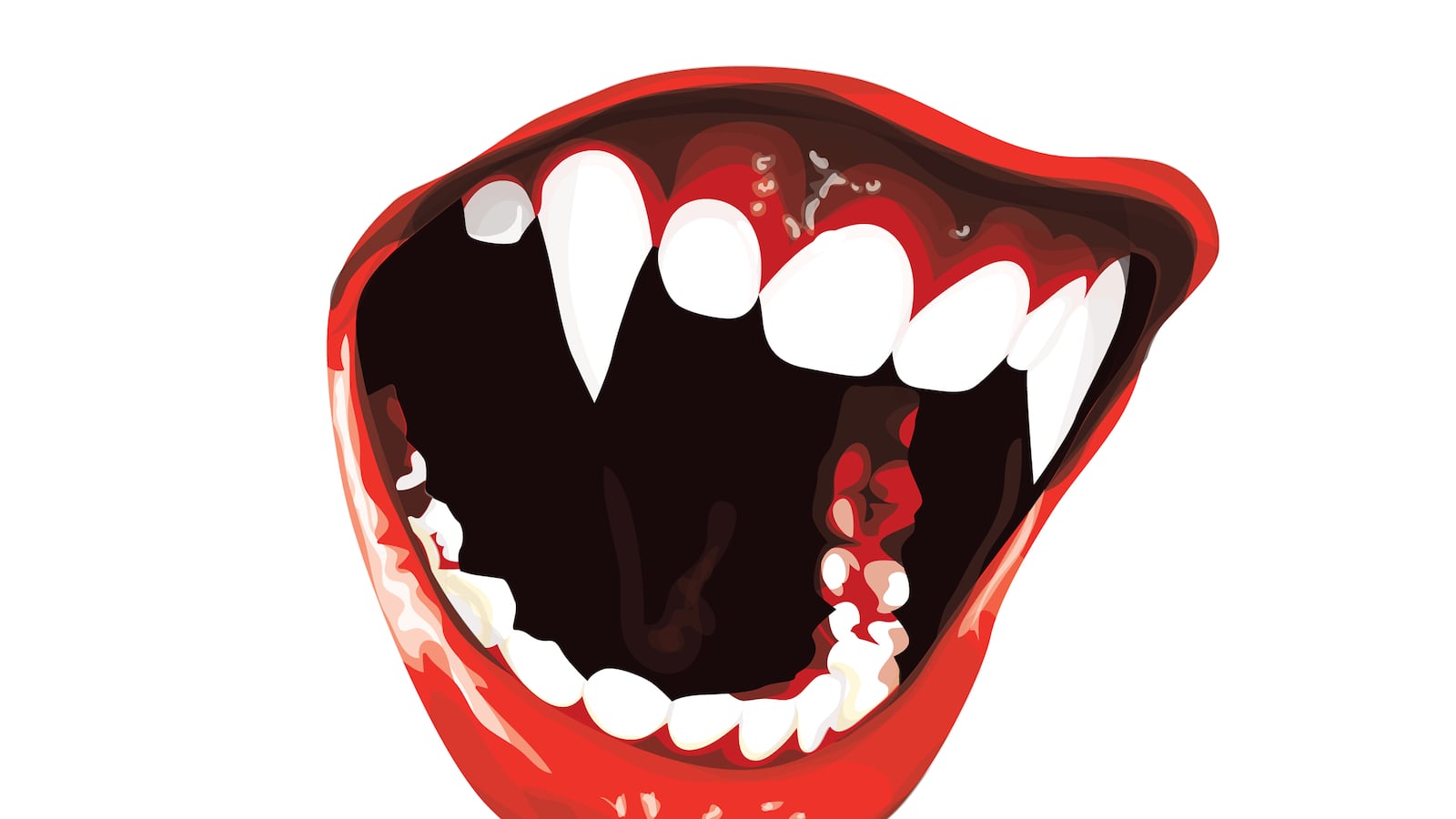“Merticus” is an Atlanta-native, husband, and dog owner. The 37-year-old listens to Radiohead, watches The Shawshank Redemption, and sells antiques. He’s a world traveler, voracious reader, and occasional poet.
Once a week, he drinks human blood.
Experts estimate there are thousands of people like him worldwide—working professionals, friends, and neighbors, who, publicly or not, identify as “real life vampires.” It wasn’t until 1997 that Merticus (a name he adopted three years earlier) “came out of the coffin” and began identifying as “vampiric.” It’s a “loosely defined” identity, he says, that includes anyone from the donors (those who offer up their blood) to role players.
To be sure, there is no scientific evidence that vampirism is a real condition, nor proof that Merticus’s symptoms aren’t simply a product of his imagination. Science and medicine reject the concept of vampirism, and it’s not difficult to see why. Feeding off another human’s blood for “survival” is, quite literally, the stuff of horror fantasy.
A small pocket of scientists—intrigued by how vehemently vampires defend their condition as authentic—have begun exploring the potential that it’s a mental disorder. Dr. Katherine Ramsland, a professor of forensic psychology at DeSales University, coined the term “Vampire Personality Disorder” several years ago. She hypothesizes that those who believe themselves to be “real life vampires” are actually suffering from a delusion-based mental illness.
For Merticus, distinguishing vampirism from mythology is just as important as defining it. “[It] is not a cult, a religion, a dangerous practice, a paraphilia, an offshoot of the BDSM community, a community composed exclusively of disillusioned teenagers, and it’s definitely not what’s depicted in fictional books, movies, or television,” he says.
Coming out of the coffin took years of research and self-reflection, a difficult path to embark on in a society that considers vampires to be blood-hungry villains. In his mind, it was less about choice than acceptance—an “awakening” to his true self. “My identity as a real vampire represents a lifelong association—not a phase or temporary affinity,” he tells me.
Despite being “fiercely private,” Merticus is open to sharing to his story. Once acquainted, he sends eloquent, novel-like emails, sharing intimate details of every aspect of his life—from weekly feedings to physical symptoms. It’s no surprise to learn that he acts as a liaison between law enforcement and academia, on top of the media.
For a community shrouded in darkness, he’s as close to a public figure as it gets.
His connection to the community, and devotion to serving it, runs deep. In 2005, he helped found the Atlanta Vampire Alliance (AVA), an organization that promotes unity and offers support to those “newly awakened.” Today, it is one of the most far-reaching organizations of real-life vampires in the world. One year later, he founded the largest vampire research company, Suscitatio Enterprises, LLC. Now he runs and operates the Vampire Community News network, an internal social media platform that he founded in 2008.
It’s one of the reasons he proved an invaluable resource for a recent study by two social workers that made headlines nationwide. Published in the journal Critical Social Work, it detailed the struggle those who identify as vampiric face in talking to social workers. It was Merticus who first contacted DJ Williams, co-author of the study, who he’d seen write about it in the past.
An associate professor of social work at Idaho State, Williams has been studying real-life vampires for more than a decade. Initially skeptical of the condition, he became convinced of its authenticity after meeting a woman who identified as a real-life vampire. Williams, the only academic that agrees to speak with me about it, is equally passionate. “We have a code of ethics and talk about being open minded, but I’m not sure we practice that with these clients,” he tells me.
Understanding real-life vampires begins with distinguished between three types. “Lifestyle” vampires are a sort of “vampire light,” if you will. Lifestylers are attracted to the vampire aesthetic, but don’t feel the need to consume blood. Their identity revolves around appearance—prosthetic fangs, all black garb, and colored contacts.
The other two types of vampires, sanguinarian and psychic, do not adopt the aesthetic. Williams defines these two types as “individuals who cannot adequately sustain their own physical, mental, or spiritual well being without the taking of blood or vital life-force energy from other sources.”
Sanguinarian vampires gain energy by drinking small amounts of blood (either human or animal); physic by feeding on “life force energy.” While Merticus harbors no resentment toward “lifestyle vampires,” he does make it a point to distinguish between the two. “I typically dress in black from head to toe but I’ve never owned a pair of prosthetic fangs,” he says. “I don’t identify specifically with the Goth culture from a social identity standpoint.”
Sanguinarian and psychic vampires consider “real vampirism” to be an extension of their identity, not a lifestyle choice. Not feeding isn’t an option. “Without feeding the vampire will become lethargic, sickly, depressed, and often go through physical suffering or discomfort,” he says.
Those who rely on feeding, Merticus being one of them, tend to stray from using the word vampire. “Self-identified real vampires use the word ‘vampire’ in a metaphorical sense because they don’t consider themselves to have supernatural powers or to be immortal beings,” he says. “Despite how ironic this may sound such vampires are fairly grounded in reality and understand they’re either energy deficient, psychic, or more acutely ‘aware’ humans who satiate their needs or desires with energy or blood.”
Most jarring in my email correspondence with Merticus is the description of the act of feeding. The process itself is surprisingly systematic. The process begins with “living donors”—people who consent to letting a real-life vampire drink their blood. Finding a donor isn’t easy; vetting them isn’t either. Most sanguinarian vampires require their living donors be screened and undergo careful medical evaluation to prevent blood-borne diseases.
Partaking of the “coveted red liquid,” as he calls it, is simpler. Generally he “feeds” once a week, anywhere from one to two tablespoons. Vampires don’t “find value” in storing blood, he says, but will sometimes resort to animal blood if a living donor is not available to “satiate their hunger.” For Merticus, the act of feeding is intertwined with sexuality. For others, it isn’t.
Unlike popular depictions of vampires, teeth are not the method used to feed. “Drawing blood through biting is not a sanitary or safe practice,” he says. Medical lancets or sterilized blades are his instrument, which he uses to make a small slit in the back. “The overwhelming majority of self-identified vampires adhere to ethical and safe feeding practices, are of sound mind and judgment, and productively contribute to society,” he says.
Merticus says the process begins with him “running his fingers” over the skin to feel a “connection” being established that will help him draw the blood. “A calming energetic vibration or tingling sensation fused with an intense heightening of virtually all of my senses envelops me when I’ve fed at a deep level with someone whose etheric body aligns with my own,” he writes.
While Merticus sees the parallels between this type of feeding and BDSM, he insists they are distinct entities. Participation in BDSM is not a prerequisite for vampirism. “Sexual intercourse is not always the end goal of a vampire who claims to feed from sexual energies,” he says. “Foreplay and the pleasure of one’s partner is often essential for being able to raise the energy necessary for a vampire to feed.”
Outside of Merticus’s testimony, there’s little else out there about real-life vampires. For a condition that revolves around drinking the blood of another live human, this isn’t surprising. Only a handful of scholars in the world view it as legitimate enough to study, a few of which have written books. Williams, in a matter of seconds, can name every title.
The research group is in regular contact, sharing their results and discoveries. None of them seem to have zeroed in on a specific “explanation.” Without one, vague theories as to the origins abound. Researcher Nick Lane theorized in a 2002 paper that vampirism is explained by porphyria, a rare blood disorder that causes intense sensitivity to sunlight. In the past, others have pointed to tuberculosis, because victims cough up blood, or catalepsy, which causes corpse-like mangling of the body. In medieval times, it was thought to be a disease of the dead. In the 1800s, it was considered a sexual condition.
A prevailing theory today is that vampires are merely blood fetishists—a label that does bear similarities to some sanguinarian vampires’ feedings. In his book Vampires Today: The Truth About Modern Vampirism, Joseph Laycock explores the connection in detail. While he acknowledges major overlaps, he points out a difference between the two: blood fetishists will consume the blood of a corpse—vampires will not.
Merticus says the two can overlap, but are not synonymous. “Blood fetishists are aroused by seeing, smelling, and touching blood,” he says. “Sanguinarian vampires believe that the drinking of small quantities of blood represents a health and quality of life issue—a need rather than a desire.”
Whether or not science will deem it worthy of serious exploration is unclear. Williams, who’s already working on another study, wants to shed more light on the topic. Merticus, it seems, just wants peace. “Whether or not this increased attention translates into increased acceptance is something that remains to be seen,” he writes. “All we ask for is an open mind, tolerance, and the right to privately live our lives.”






